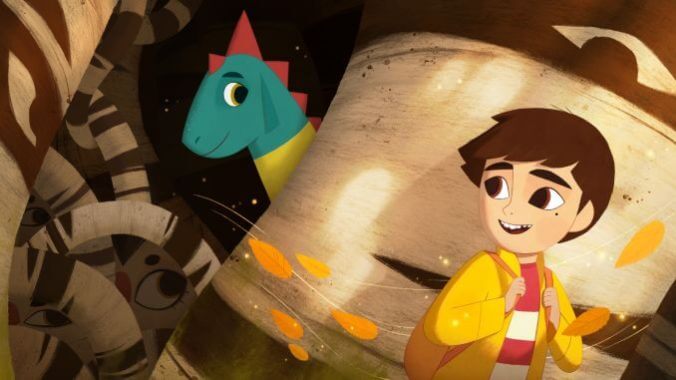My Father’s Dragon Soars as a Delightful Journey into the Surreal and Poignant

When it comes to contemporary animation, we live in a reality where the majority of studios making theatrical films in the medium are all-in on CG. Pixar, Walt Disney Animation, Illumination…they’ve all poo-pooed traditional 2D animation. This is why fans of the medium have to root out and celebrate the smaller studios consistently committed to providing audiences with brilliant, creative animation that honors the origins of the tradition. Ireland’s Cartoon Saloon is one of those proverbial salmon swimming upstream going up against the ones and zeroes, and thank goodness for their tenacity. Their latest film, My Father’s Dragon, is directed by studio co-founder Nora Twomey and based on the beloved children’s book of the same name created by Ruth Stiles Gannett. This adaptation brings to life, in gorgeous 2D animation, a kaleidoscope of surreal visuals and strange creatures encountered by a little boy and his dragon friend. Theirs is an intimate story about processing fear, especially speaking to those children wrestling with the burdens of having to emotionally navigate real-world stresses that invade their lives too soon.
Like Gannett’s book, My Father’s Dragon is also narrated (sparsely) by the unseen grown child (Mary Kay Place) of the story’s protagonist, Elmer Elevator (Jacob Tremblay). She sets up an adventure Elmer had in his childhood that not only utilized his talent for finding things, but was also life-changing. It occurred at a pivotal point in his young life, when his single mother Dela (Golshifteh Farahani) had to sell their small grocery store and move to the big city for work. Impoverished, losing their beloved livelihood and their community, Elmer and Dela are adrift in a much darker, much more dour world—one that they aren’t sure how to navigate.
Seeing Elmer so upset, Dela tries to bolster his hope by pointing out a boarded-up storefront that they can save towards, one that can perhaps be their new store. But it’s a pipe dream that Elmer, unfortunately, latches onto as his new goal. He utilizes the few items, like a cracked mirror and box of rubber bands, that he was able to save from their former store to find ways to add to their very meager savings, but that dries up as Dela has to use the money in pursuit of a new job. It breaks Elmer’s heart, which prompts him to have a huge row with his mom and run away. A stray cat (Whoopi Goldberg) who benefited from his kindness follows him and tells him about a dragon that lives out on an island that can save his shop dream. Yes, Elmer is dumbfounded that a cat can talk, but it’s the gateway to a whole world of critters that he’ll encounter on his way to the dragon’s Wild Island.
Twomey and her team of artists have created both real and magical worlds that look ripped from the pages of a top-shelf children’s book, which works perfectly with the Roald-Dahl-meets-Studio-Ghibli vibe of the film. The color palette is bold and layered with flora and fauna that is familiar, yet skewed towards the magical and exaggerated. And all of the creatures have delightfully original designs, featuring caricature-style flourishes that make every wild character, from the macaques to the rhinos and the crocodiles, feel fresh and slightly surreal. There are also myriad, clever, repeated design motifs that carry through from the human world to the wild world, which augments the care infused into the film. Every frame has something gorgeous to look at and get lost in, which is what you want from an animated film where imagination is key to the story.
-

-

-

-

-

-

-

-

-

-

-

-

-

-

-

-

-

-

-

-

-

-

-

-

-

-

-

-

-

-

-

-

-

-

-

-

-

-

-

-








































